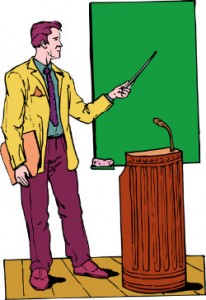Teaching History: The Five-Minute Lecture Rule
A MiddleWeb Blog

As I thought about my first post here for the 2014-15 school year, I was overwhelmed with the number of things about which I could write and the amount I could say about any one subject. So I decided this would be the ideal time to extoll the virtues of brevity.
Brevity is great.
More specifically, I have been trying to keep myself to a very stringent five-minute rule when talking to (at) my class as a whole. I have not always been able to adhere to my rule, but having the rule in place (and telling my students about the rule) has helped keep me on course, and I have been able to foster a classroom in which cooperative learning is the norm.
Why five minutes?
I settled on five minutes for the same reason I tell my students they have three minutes to work on something I will actually give them 10 minutes to complete. A 10-minute rule would result in 15- minute lectures, which would eventually allow me to cheat to 20 minutes, and so on.

I have also found that the best use of my time in front of the class is to clarify the instructions for an activity or to guide a brief discussion at the end of a lesson. The students who understand the assignment are bored if I take too long to explain it, and students who do not catch on after five minutes usually need me to address their questions in person.
Because I have students in mixed-ability teams, there is usually at least one person at every table who can explain the assignment to confused peers after I give a brief overview.
My students didn’t “get it,” can I lecture now?
More than any other subject, history presents the illusion of a shortcut to student learning. Even when we are focused on helping students to develop essential literacy and critical thinking skills, there is still a great deal of content that is covered in the process.
Students who struggle with reading comprehension and knowledge retention, as the majority of mine do, will often believe they have finished an assignment, despite the fact that they cannot tell me even the most rudimentary details about the text at the heart of the lesson. The inclination is to “fill in the gaps” with lectures, to make sure the students “know the basics.”

The other problem is the sidelining of skills for the sake of content. This is not to say that content is not important. Without content, skills are meaningless, just as a recipe is useless without food. However, if students fail to incorporate content into their schemas after a facilitated learning activity involving texts and other media, then the students still need to develop the skills necessary to “get it” the next time. The focus should be on how to access the information, not necessarily the information itself.
Rules were made to be broken
Naturally, there will be times when it makes sense to be in front of the class for more than five minutes.
When I am introducing new units, I often take a moment to show the students a few maps, visuals or other aids that I think will help them as they read. During these introductory sessions I will field questions, and this means I generally go over time.
Additionally, if, as my students are working in teams, it is clear that one particular group understood the assignment in greater depth than others, I will ask them to share their ideas with the rest of the class, even if that takes more time than I allot for lecture. There are also a handful of entertaining 10- to 15-minute lectures that I have honed over the years that I still give because they are almost always well-received.
While I have lots more I would like to share about the classroom and my endeavors to hand the responsibility for learning to my students, I’m afraid I have already gone way over my five minutes.
Editor’s note: If you have more than five minutes, browse here to find other Aaron Brock posts about teaching history in schools where literacy issues are significant.

































I am a student teacher of U.S. History and I would love to hear some ways to teach history other than lecture. What kind of activities do you do? My mentor teacher is primarily a lecturer but that is not my strong suit.
Yes, please share some ways to teach it without lecturing! Searching for ideas is how I found your blog.
To read more about Aaron Brock’s teaching strategies, browse this list of his other MiddleWeb posts.
@Mary: Thanks for reading. I have recently been doing a lot of work with annotation. There are ways to help wean students off of direct teaching through annotation, with the long term goal being completely independent reading, learning and evaluation.
One simple way to bridge the gap between lecture and reading is to create a “visuals only” slideshow. After students have had a few minutes to skim a text, show them the slides, and ask them to mark the line or lines that go with each visual (pictures, maps, etc.). Then have students discuss with one another and then share with the class. This basically allows students to formulate their own ideas, then help one another correct any misunderstandings about what they’re reading. The teacher acts as a facilitator, guiding the classroom conversation to avoid outright misreading and to help students deepen their understanding.
Of course, this should then be followed up by more in-depth annotation and writing (look for the “5Ws,” look for cause and effect, look for author bias). As students get used to the idea that they are the ones creating the meaning of the text through their annotation, they will become more comfortable sharing ideas and teaching one another as you provide progressively more sophisticated texts.
Hope this helped (a little).